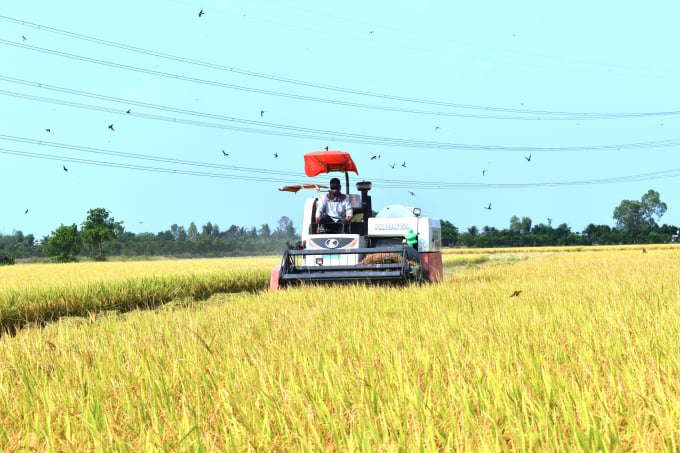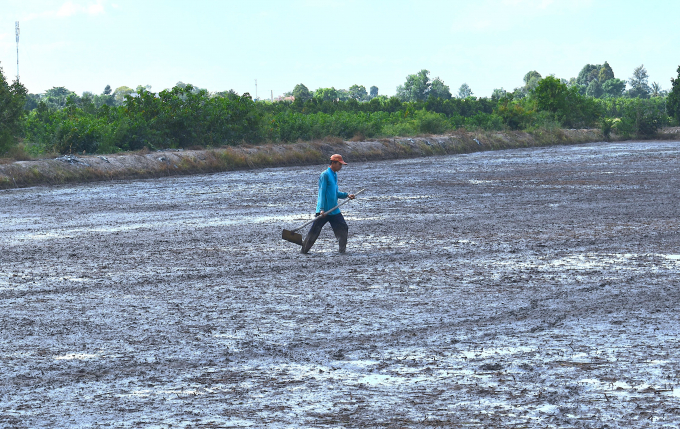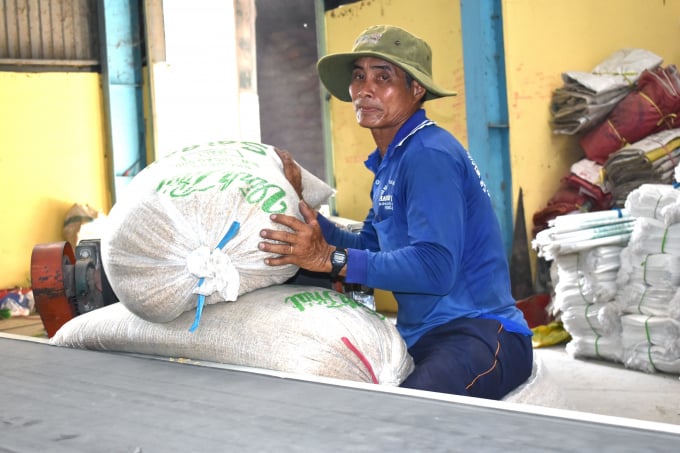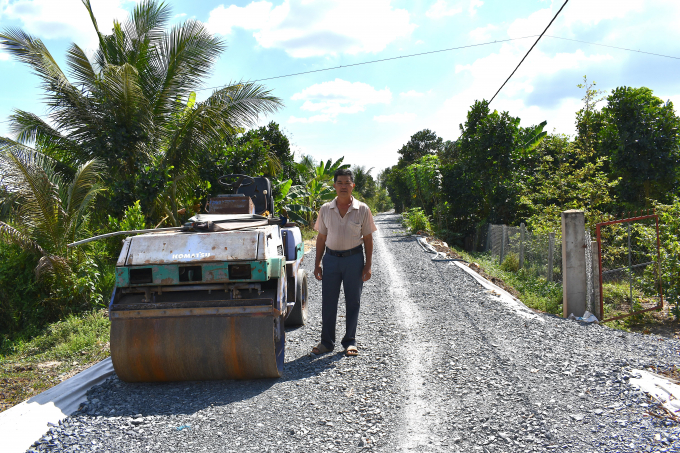May 24, 2025 | 16:29 GMT +7
May 24, 2025 | 16:29 GMT +7
Hotline: 0913.378.918
May 24, 2025 | 16:29 GMT +7
Hotline: 0913.378.918

The VnSAT project has transferred many scientific and technical advances to Mekong Delta farmers. Photo: Minh Dam.
Tien Giang is one of the Mekong Delta provinces with high-quality rice production areas. The successes in rice production have brought significant benefits to rice growers and made outstanding contributions to the province's socio-economic development.
However, in the period 2010-2015, rice production costs such as materials and labor have surpassed the profit level of rice growers. Many old farming practices of the people also cause difficulties in rice production and consumption.
Mr. Cao Van Hoa, Director of the Vietnam Sustainable Agriculture Transformation Project ("VnSAT project') in Tien Giang province, said: Due to the habit of sowing thickly, from 180 kg-200 kilograms per hectare, along with inappropriate use of pesticides and fertilizers, have increased pests and diseases for rice.
Therefore, rice production needs to be changed in the direction associated with sustainable value chain development. It is also the goal of agriculture restructuring in Tien Giang province.
Tien Giang is one of 13 provinces and cities participating in the VnSAT Project from 2015. The project is implemented in 3 districts and towns: Cai Be, Cai Lay, and Cai Lay town. The project area has 20 communes with over 27,200 hectares and more than 41,000 households.

The Project has trained farmers to produce rice according to VietGAP standards, crop rotation, make use of rice by-products, certified rice breeding. Photo: Minh Dam.
From the beginning, the VNSAT Project's Management Board in Tien Giang province focused on continuously implementing training. The Project has carried out 855 training classes "3 decrease, 3 increase" and 476 training classes "1 right, 5 decrease", and 42 thematic classes on cooperative management and development.
In addition, the Project has trained farmers to produce rice according to VietGAP standards, crop rotation, make use of rice by-products, certified rice breeding.
Mr. Cao Van Hoa, Director of the VnSAT Project Management Board in Tien Giang province, assessed: Over the past five years, the Project has changed the rice production habits of farmers. Farmers who have converted from traditional rice farming to rice farming apply the technical process of "3 decrease, 3 increase", "1 must 5 decrease", which helps reduce the quantity of seed sown, irrigation water, and post-harvest losses. The average profit of rice production in the project area increased by 36.4%.
The Project also supported the establishment of 16 new cooperatives. Currently, the Project has 19 cooperatives and one cooperative group. From the support of the Project, the Board of Directors and members of the cooperative are trained on advanced rice production processes.

In Tien Giang province, the profitability of rice farming in the project area is 36% higher than outside. Photo: Minh Dam.
The Project has developed production linkages with enterprises, serving as the basis for sustainable rice production. By now, there have been 16 farmer organizations participating in linking rice consumption with enterprises with 8,389 hectares.
By the end of 2021, the number of beneficiaries of the Project is over 108,800 people, reaching 153% of the set target. The area of sustainable farming is around 17,800 hectares, reaching 112%. The increase in profit/hectare of productive land of farmers was 36.4%/30%, reaching 121%. The amount of greenhouse gas emissions in rice farming is estimated to decrease by 121,255 tons, reaching 114%.
The VnSAT Project's Management Board has coordinated with localities to propose a list of investment infrastructure works in cooperatives that have met training criteria and carry out investment procedures following World Bank regulations and the Government of Vietnam.
Up to now, Tien Giang province has 20 sub-projects, and one project has been and is being invested such as upgrading 27 rural roads with asphalt and concrete structures, with a total length of nearly 74 kilometers; 36 bridges; 30 regulating culverts, combined culverts with pumping stations; 7 warehouses for temporary storage; 1 drying oven; etc.

The VnSAT project also supports rural infrastructure in localities. Photo: Minh Dam.
In addition, the Project has also supported the Department of Agriculture and Rural Development's units with much infrastructure, equipment, and goods. The testing and inspection of rice seeds and the testing and testing department have been granted ISO 17025: 2017 certification.
According to Mr. Cao Van Hoa, Director of the VnSAT Project's Management Board in Tien Giang province, said: "During the implementation of the project, we have received the support of experts from the World Bank, the Ministry of Agriculture and Rural Development, the Central Project Management Board and specialized agencies of the Ministry of Agriculture and Rural Development. The project has made an essential contribution to climate change adaptation of rice production.
In Long An province, thanks to the VnSAT project, the quantity of seed used before was reduced from 145 kilograms per hectare to 110 kilograms. Besides, the nitrogen fertilizer decreased from 120 kilograms to 98 kilograms per hectare. The spraying times 4.8 times were also reduced to 3 times compared to before.
The VnSAT Long An's Project Management Board strengthens the coordination of training and transfer of science and technology to farmers. Also, the province will reorganize production in the direction of concentration, supporting the development of farmer organizations and cooperatives meeting project criteria.
In addition, the Department of Agriculture and Rural Development will quickly deploy and soon complete the sub-projects to continue mobilizing farmers to join cooperative groups and cooperatives to build production models, supply materials, and consume products; maintain and expand the deployment area until the project ends.
Translated by Ha Phuc

(VAN) The People's Committee of Tra Vinh province has approved an adjustment to the investment policy for the Green Hydrogen Plant project, increasing its area to approximately 52.76 hectares.
![Reducing emissions from rice fields: [2] Farmers’ commitment to the soil](https://t.ex-cdn.com/nongnghiepmoitruong.vn/608w/files/news/2025/05/05/dsc08881jpg-nongnghiep-140632.jpg)
(VAN) Clean rice cultivation model in Thuong Tan commune, Bac Tan Uyen district, is assisting local residents in achieving sustainable agriculture by substantially reducing costs, increasing productivity, and protecting the environment.

(VAN) At the conference to disseminate Resolution No. 68, AgriS introduced its digital agricultural ecosystem and reaffirmed its commitment to accompanying the Government in promoting private sector development and sustainable agriculture.

(VAN) 'Blue Ocean - Blue Foods' initiative is designed to restore marine ecosystems and establish sustainable livelihoods for local communities by cultivating a minimum of 1,000 hectares of cottonii seaweed in the first three years.
/2025/05/21/4642-3-112707_603.jpg)
(VAN) The V-SCOPE project has made direct contributions to three out of six pillars of the Comprehensive Strategic Partnership between Vietnam and Australia.

(VAN) Facing the threat of rabies spreading to the community, Gia Lai province urgently carries out measures to vaccinate dogs and cats on a large scale.

(VAN) Disease-free livestock farming not only protects livestock herds but also stabilizes production and livelihoods for many farmers in Tuyen Quang.